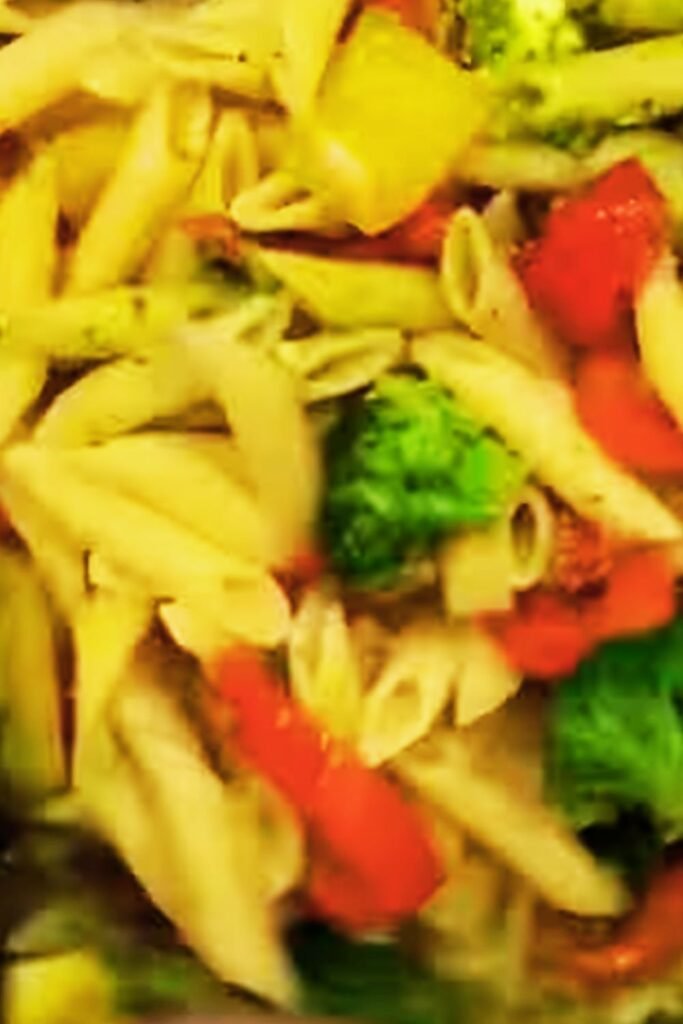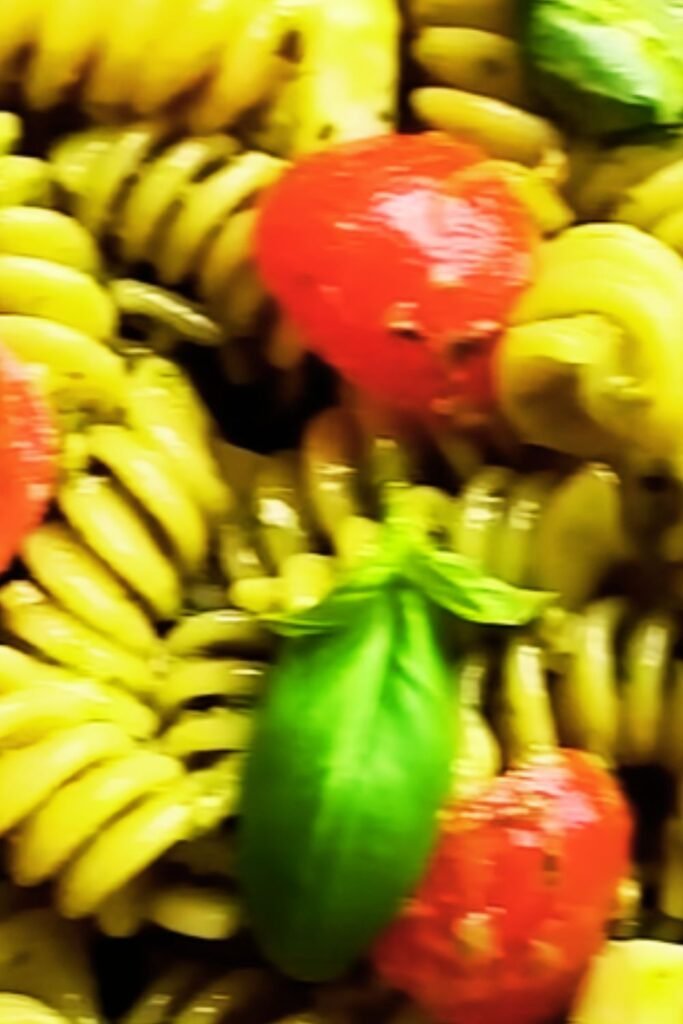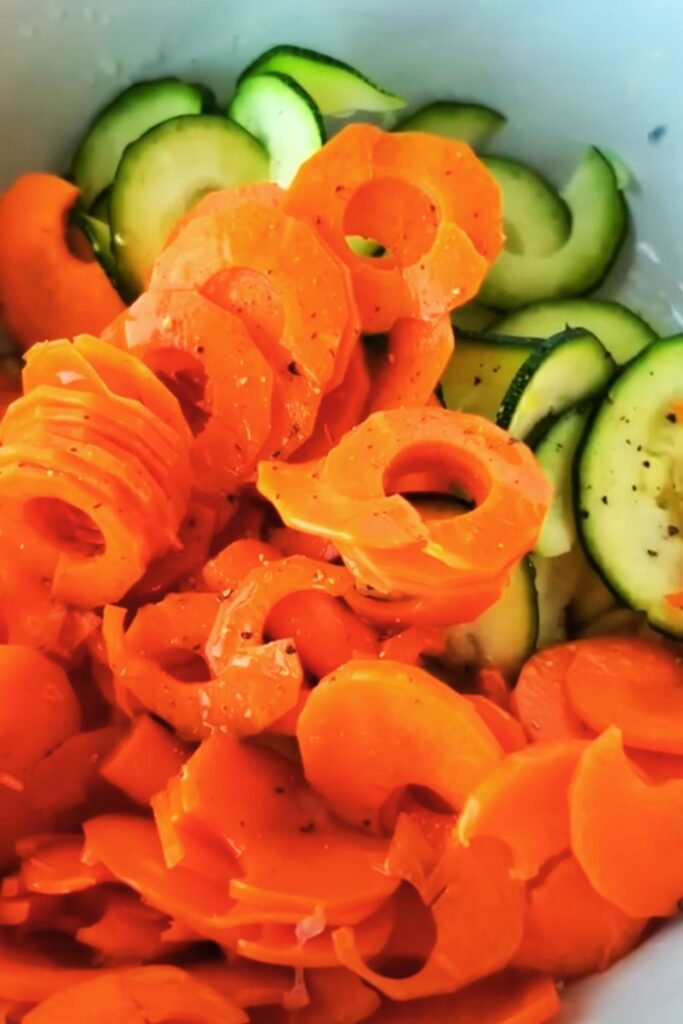When I first discovered the magic of combining vibrant vegetables with aromatic basil pesto in a single baking dish, my weeknight dinners were forever changed. This Vegan Pesto Veggie Bake has become my go-to recipe when I want something that’s both nutritionally dense and incredibly satisfying. The beautiful thing about this dish is how it transforms simple, everyday vegetables into something that feels restaurant-worthy, all while being completely plant-based and packed with nutrients.
I’ve been perfecting this recipe for years, and what I love most is how adaptable it is to whatever vegetables you have on hand. Whether you’re dealing with a CSA box full of seasonal produce or just trying to use up those vegetables languishing in your crisper drawer, this recipe welcomes them all with open arms.
Understanding the Foundation: What Makes This Veggie Bake Special
Layered Flavor Profile: The secret to this dish lies in building layers of flavor through proper seasoning, the right vegetable combinations, and that gorgeous vegan pesto that ties everything together.
Textural Contrast: By combining vegetables with different cooking times and textures, we create a bake that’s never boring – some vegetables become tender and sweet, others maintain a slight bite, and the pesto creates creamy pockets throughout.
Nutritional Powerhouse: This isn’t just comfort food; it’s a complete meal that delivers protein, healthy fats, complex carbohydrates, and a rainbow of vitamins and minerals.
Meal Prep Friendly: One of my favorite aspects is how well this dish keeps and reheats, making it perfect for busy weeks when you want healthy meals ready to go.
The Art of Vegan Pesto: Creating the Perfect Base
Before we dive into the full recipe, let me share what I’ve learned about making exceptional vegan pesto. Traditional pesto relies on Parmesan cheese for that umami depth and creamy texture, but I’ve discovered several plant-based alternatives that create an even more complex flavor profile.
Nutritional Yeast: This is my secret weapon for that cheesy, nutty flavor that makes people question whether this pesto is truly vegan.
Cashews or Pine Nuts: While pine nuts are traditional, I often use cashews for their creamy texture and more affordable price point.
Fresh Herbs: Beyond basil, I love experimenting with combinations that include spinach, arugula, or even fresh mint for unexpected brightness.
Quality Olive Oil: This is where you don’t want to skimp – a good extra virgin olive oil makes all the difference in the final flavor.

Selecting the Perfect Vegetables: A Guide to Combinations That Work
Over the years, I’ve experimented with countless vegetable combinations, and I’ve learned that success lies in understanding cooking times and flavor compatibility. Here’s my approach to selecting vegetables that work beautifully together:
Root Vegetables: These take the longest to cook, so I always cut them smaller or give them a head start. Sweet potatoes, carrots, parsnips, and beets all work wonderfully.
Mediterranean Classics: Zucchini, eggplant, bell peppers, and tomatoes are natural partners that cook at similar rates and complement the pesto beautifully.
Cruciferous Champions: Broccoli, cauliflower, and Brussels sprouts add great texture and nutritional value, though they need proper timing to avoid overcooking.
Alliums for Depth: Red onions, shallots, and garlic (beyond what’s in the pesto) add layers of flavor that develop beautifully during roasting.
Detailed Ingredient Breakdown and Nutritional Information
| Ingredient Category | Primary Ingredients | Nutritional Benefits | Flavor Contribution |
|---|---|---|---|
| Base Vegetables | Zucchini, bell peppers, eggplant | High in fiber, vitamins A & C, potassium | Sweet, earthy foundation |
| Root Vegetables | Sweet potatoes, carrots | Beta-carotene, complex carbs, vitamin A | Natural sweetness, hearty texture |
| Protein Additions | Chickpeas, white beans | Plant protein, fiber, iron, folate | Creamy texture, protein boost |
| Pesto Components | Fresh basil, nutritional yeast, nuts | B-vitamins, healthy fats, antioxidants | Herbal brightness, umami depth |
| Aromatics | Garlic, red onion, fresh herbs | Allicin, quercetin, various antioxidants | Flavor complexity, aromatic base |
Step-by-Step Preparation: My Foolproof Method
Preparing the Vegan Pesto (Makes about 1 cup)
The pesto is the heart of this dish, so I always make it first to let the flavors meld while I prepare the vegetables.
Ingredients for Pesto:
- 2 cups fresh basil leaves, packed
- 1/2 cup raw cashews, soaked for 30 minutes
- 1/4 cup nutritional yeast
- 3 cloves garlic, minced
- 1/2 cup extra virgin olive oil
- 2 tablespoons lemon juice
- 1 teaspoon sea salt
- 1/4 teaspoon black pepper
Method:
- Start by soaking your cashews in warm water for 30 minutes – this creates the creamiest texture
- Drain the cashews and add them to a food processor with garlic and nutritional yeast
- Pulse until you have a coarse meal
- Add basil leaves and pulse again until roughly chopped
- With the processor running, slowly drizzle in olive oil until you reach your desired consistency
- Add lemon juice, salt, and pepper, then pulse to combine
- Taste and adjust seasoning – I often add an extra pinch of salt to really make those flavors pop

Vegetable Preparation and Assembly
Main Vegetables (serves 6-8):
- 2 medium zucchini, sliced into half-moons
- 1 large eggplant, cubed
- 2 bell peppers (any color), sliced
- 1 large sweet potato, cubed
- 1 red onion, sliced
- 1 cup cherry tomatoes, halved
- 1 can (15 oz) chickpeas, drained and rinsed
Preparation Steps:
- Preheat your oven to 425°F (220°C) – this high heat is crucial for achieving that perfect caramelization
- Line a large baking sheet or roasting pan with parchment paper
- Cut all vegetables into similar-sized pieces to ensure even cooking
- For the eggplant, I like to salt it lightly and let it sit for 15 minutes to draw out any bitterness, then pat dry
- In a large bowl, toss all the vegetables with 2-3 tablespoons of olive oil and season generously with salt and pepper
- Arrange vegetables in a single layer on your prepared baking sheet – don’t overcrowd, use two pans if necessary
The Baking Process: Timing and Technique
Initial Roasting:
- Place the vegetables in the oven and roast for 25-30 minutes, stirring once halfway through
- Look for vegetables that are starting to caramelize around the edges and are tender when pierced with a fork
- The sweet potatoes should be the test – when they’re tender, everything else will be perfectly cooked
Adding the Pesto:
- Remove the vegetables from the oven and reduce temperature to 375°F (190°C)
- Dollop the pesto over the roasted vegetables – I like to add it in several spots rather than trying to mix it in completely
- Gently fold some of the pesto into the vegetables, leaving some visible streaks for visual appeal
- Return to oven for an additional 10-15 minutes

Customization Options and Seasonal Variations
Spring Variation
In spring, I love incorporating asparagus, fresh peas, and baby artichokes. The pesto can be enhanced with fresh mint and lemon zest for a brighter flavor profile.
Summer Abundance
Summer is when this dish truly shines with peak-season vegetables. I often add corn kernels, summer squash varieties, and fresh tomatoes of every color. A pesto made with a combination of basil and fresh oregano works beautifully.
Fall Comfort
Autumn calls for heartier vegetables like butternut squash, Brussels sprouts, and beets. I sometimes add dried cranberries for a touch of sweetness and make the pesto with roasted garlic for deeper flavor.
Winter Warmth
In winter, I focus on storage vegetables like parsnips, turnips, and winter squash. The pesto can be enhanced with rosemary and sage for more warming flavors.
Storage and Meal Prep Tips
| Storage Method | Duration | Best Practices | Reheating Instructions |
|---|---|---|---|
| Refrigerator | 4-5 days | Store in airtight container, keep pesto and vegetables separate if possible | Reheat in oven at 350°F for 15-20 minutes |
| Freezer | 2-3 months | Freeze in portion-sized containers, pesto may separate slightly | Thaw overnight, reheat in oven, may need fresh pesto drizzle |
| Meal Prep | 3-4 days | Prepare vegetables and pesto separately, combine when ready to eat | Best results when reheated in oven rather than microwave |
Nutritional Analysis and Health Benefits
This Vegan Pesto Veggie Bake is more than just delicious – it’s a nutritional powerhouse that delivers impressive health benefits in every serving.
Per Serving (based on 6 servings):
- Calories: 285
- Protein: 9g
- Carbohydrates: 32g
- Fiber: 8g
- Healthy Fats: 15g
- Vitamin A: 180% DV
- Vitamin C: 85% DV
- Folate: 25% DV
- Potassium: 650mg
The combination of colorful vegetables provides a wide array of phytonutrients, antioxidants, and anti-inflammatory compounds. The chickpeas add plant-based protein and fiber, while the nuts in the pesto contribute healthy monounsaturated fats that help with nutrient absorption.
Serving Suggestions and Complementary Dishes
I’ve served this veggie bake in countless ways, and here are my favorite approaches:
As a Main Dish: Serve over quinoa, brown rice, or pasta for a complete meal. I particularly love it over creamy polenta or with crusty sourdough bread for dipping.
As a Side: This makes an excellent side dish for grilled portobello mushrooms, herb-crusted tofu, or any plant-based protein.
For Entertaining: I often make this for dinner parties because it’s impressive yet easy. Serve with a simple arugula salad and some good olive bread.
Breakfast Option: Leftover veggie bake makes an incredible base for a breakfast bowl – just top with avocado and hemp seeds.
Troubleshooting Common Issues
Problem: Vegetables are mushy Solution: This usually happens from overcrowding the pan or cutting vegetables too small. Ensure vegetables are in a single layer and cut to appropriate sizes.
Problem: Pesto turns brown Solution: This is oxidation from the basil. Add lemon juice immediately after making, and consider blanching basil briefly before processing.
Problem: Dish is too oily Solution: Drain vegetables well if they release a lot of water during cooking, and use pesto sparingly – you can always add more.
Problem: Flavors seem flat Solution: Don’t forget to season your vegetables before roasting, and taste your pesto for proper salt balance.
Advanced Techniques for Restaurant-Quality Results
After years of making this dish, I’ve developed some techniques that elevate it from good to extraordinary:
Pre-salting: For vegetables like eggplant and zucchini, pre-salting draws out moisture and concentrates flavors.
Temperature Control: Starting at high heat for caramelization, then reducing temperature prevents burning while ensuring everything cooks through.
Pesto Timing: Adding pesto in the final minutes prevents it from becoming bitter or losing its vibrant color.
Finishing Touches: A drizzle of good balsamic vinegar or a sprinkle of fresh herbs just before serving adds professional polish.
Questions and Answers
Q: Can I make this dish ahead of time for meal prep?
I absolutely recommend making this ahead! In fact, I think it tastes even better the next day as the flavors have time to meld together. You can prepare the entire dish up to 3 days in advance. Store it covered in the refrigerator and reheat in the oven at 350°F for about 15-20 minutes. If you’re planning to freeze portions, I suggest keeping some extra pesto on hand to freshen up the flavors after reheating.
Q: What’s the best way to prevent the vegetables from becoming too soggy?
Great question! The key is proper moisture management. First, make sure you’re not overcrowding your baking pan – vegetables need space to roast rather than steam. Second, if you’re using vegetables with high water content like zucchini or eggplant, I recommend salting them lightly and letting them sit for 15 minutes before cooking to draw out excess moisture. Finally, pat everything dry before tossing with oil and seasonings.
Q: Can I substitute the cashews in the pesto with other nuts?
Absolutely! While cashews create the creamiest texture, pine nuts are the traditional choice and work beautifully. Walnuts add a slightly bitter note that some people love, and sunflower seeds make an excellent nut-free option. Each nut will change the flavor profile slightly, so feel free to experiment based on your preferences and what you have available.
Q: How do I know when the vegetables are perfectly cooked?
I use the sweet potato as my indicator vegetable since it takes the longest to cook. When a fork easily pierces the sweet potato cubes, everything else should be perfectly tender. You want the vegetables to be caramelized around the edges with some golden-brown spots, but still holding their shape. The total cooking time is usually 35-45 minutes, depending on how you’ve cut your vegetables.
Q: Is there a way to add more protein to make this a complete meal?
Definitely! The chickpeas in the recipe already provide plant-based protein, but you can boost it further. I often add cubed extra-firm tofu that I’ve pressed and lightly seasoned – just toss it with the vegetables during the initial roasting phase. White beans, tempeh, or even cooked lentils work wonderfully too. For non-vegans, this dish pairs beautifully with grilled chicken or fish.
Q: Can I use store-bought pesto instead of making my own?
While homemade pesto definitely tastes better and allows you to control the ingredients, good-quality store-bought vegan pesto can work in a pinch. Look for brands that use real ingredients and avoid those with too many preservatives. You might need to thin it out with a little olive oil or lemon juice, and I’d recommend adding some fresh herbs to brighten the flavor.
Q: What’s the best way to reheat leftovers without drying them out?
I always recommend reheating in the oven rather than the microwave for the best texture. Cover the dish with foil and reheat at 350°F for 15-20 minutes. If it seems dry, drizzle a little olive oil or add a small dollop of fresh pesto before reheating. You can also add a splash of vegetable broth to create some steam under the foil.
Q: How can I adjust this recipe for different dietary restrictions?
This recipe is naturally vegan and gluten-free, but it’s easily adaptable for other needs. For nut-free diets, replace the cashews in the pesto with sunflower seeds or hemp hearts. For low-oil diets, you can roast the vegetables with vegetable broth instead of oil, though you’ll lose some of the caramelization. For keto diets, focus on lower-carb vegetables and increase the nuts in the pesto.
This Vegan Pesto Veggie Bake has become one of my most requested recipes, and I hope it brings as much joy to your kitchen as it has to mine. The beauty lies not just in its flavors, but in its flexibility and the way it transforms simple vegetables into something truly special. Whether you’re feeding a family, meal prepping for the week, or entertaining friends, this dish delivers on all fronts – nutrition, flavor, and visual appeal that never fails to impress.